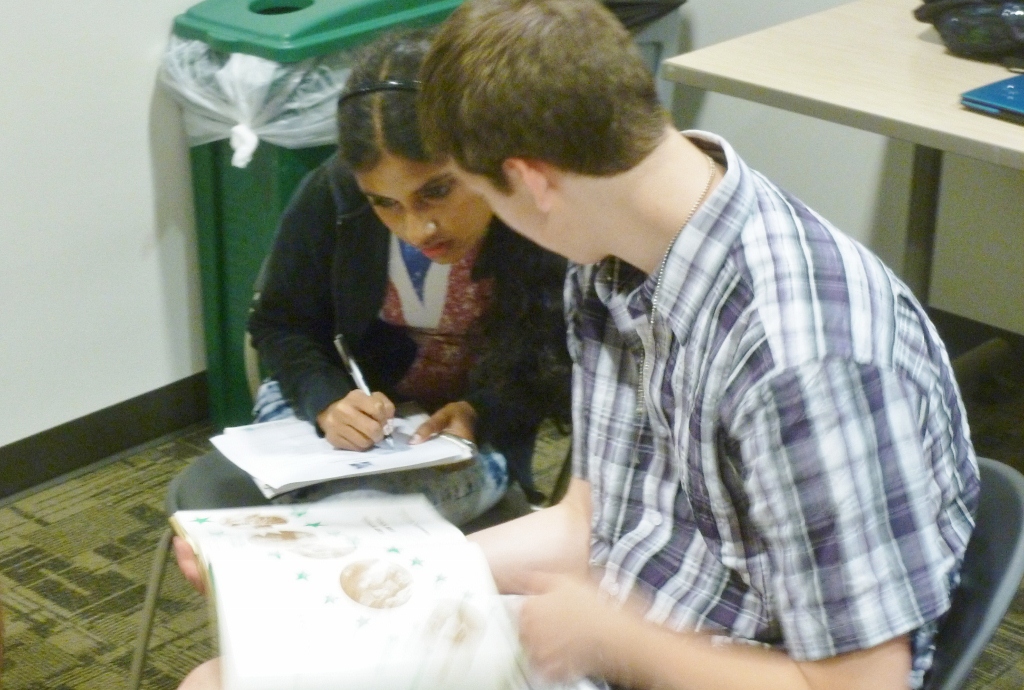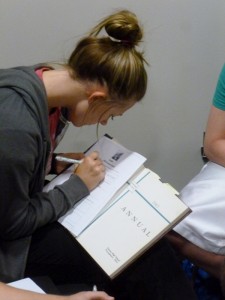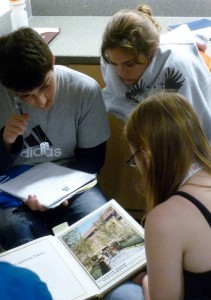Normandy Scholars Study Wartime Yearbooks, Develop Closer Connection with WWII Generation

“Something that was very different was that they had typewriter classes” said Richard Otis of Bradford, Vermont after examining the 1944 yearbook from Carl Schurz High School in Chicago, Illlinois. The afternoon session for Wednesday, June 20 allowed the Normandy Scholars to study wartime high school yearbooks to help give the students a sense of the Home Front. Richard joked that the typewriter classes belonged in the Stone Age, but he also noted the overt patriotism throughout the book. The first page was dedicated to all the graduates of Schurz High School who served.
Patriotism was a hallmark of all the yearbooks. Lacy Myrman of Brooklyn Park, Minnesota observed that every page of the 1945 Kankakee High School (Illinois) yearbook had a quote from a military or political leader such as Winston Churchill, Dwight D. Eisenhower, and Chester Nimitz. Every yearbook had a section honoring alumni who had served or were serving. Timelines of World War II events appeared several of the yearbooks.
Other students noticed societal differences in the nearly 70-year-old yearbooks. Tiffany Shumack of San Diego noticed the segregation within a school in Topeka, Kansas. Both white and black students attended the school, but many of the clubs and the school’s prom were segregated. Schools in urban areas such as Milwaukee, Chicago, and Oklahoma City showed almost no diversity among the student body, a very different setting from the schools that the Normandy Scholars attend today.
 Taylor Bromlow of Canton, Oklahoma studies a WWII-era yearbook |
 Richard Otis of Bradford, Vermont takes notes on his group's yearbook |
During the morning sessions, the students continued to experience lectures from renowned scholars. Up first was Dr. Sarandis “Randy” Papadopoulos, Secretariat Historian at the Department of the Navy. His lecture, Planning and Preparing for Operations Neptune and Overlord detailed the immense planning that went into these operations. The students were in awe at the sheer numbers of men, vehicles, and supplies that had to be put ashore in 24 hours.
Next up was Dr. Ray Batvinis of George Washington University with a very popular lecture called The Secret War: Intelligence and Deception in the Normandy Campaign. Dr. Batvinis served as an FBI agent and teaches classes on the history of the FBI. His knowledge of intelligence operations gave his lecture an extra layer of credibility. The students listened intently to the story of Juan Pujol Garcia, codenamed GARBO by the British. Garcia created a false identity and gained the trust of Hitler while convincing the Germans that the Allied invasion would come at Calais, where the English Channel was narrowest. Garcia was so trusted by the Germans that he received an Iron Cross for his work along with honors he received from Great Britain
On Thursday, the fifteen Normandy Scholars and their teachers will board a plane for Paris, France where a bus to the town of Bayeux will be waiting. On Saturday morning, the group will visit Pegasus Bridge and the Museum of the Atlantic Wall.
This post by Louisiana History Day Coordinator Nathan Huegen
Related Posts – WWII Yearbooks




Leave a Reply